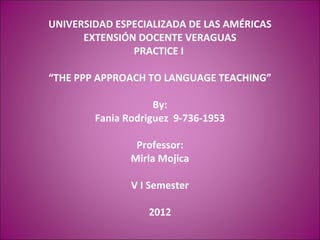The ppp approach to language teaching
- 1. UNIVERSIDAD ESPECIALIZADA DE LAS AM├ēRICAS EXTENSI├ōN DOCENTE VERAGUAS PRACTICE I ŌĆ£THE PPP APPROACH TO LANGUAGE TEACHINGŌĆØ By: Fania Rodriguez 9-736-1953 Professor: Mirla Mojica V I Semester 2012
- 2. THE PPP APPROACH TO LANGUAGE TEACHING : 1- PRESENTATION : 2- PRACTICE : 3- PRODUCTION :
- 3. WHAT IS PRESENTATION ? Presentation involves the building of a situation requiring natural and logical use of the new language. With this children know what they will learn and why.
- 4. FEATURES OF THE PRESENTATION ’āśMeaningful ’āśMemorable and realistic examples ’āśLogical connection ’āśContext ’āśClear models ’āśSufficient meaningful repetition ’āś Staging and fixing ’āśBriefness and recycling
- 5. WHAT IS PRACTICE ? Practice is the testing procedure for accuracy, and the frequency procedure for familiarity with the language. The goal of this stage is to help the children use the new language .
- 6. PRACTICE ACTIVITIES NEED TO BE : ’āśClear and understandable ’āśPromote confidence ’āśAttractive ’āśChallenge but within reach
- 7. WHAT IS PRODUCTION ? Production involves creating a situation requiring the language that was introduced in the Presentation Stage. This stage can help motivate children to communicate meaning with the new language.
- 8. EXAMPLES OF PRODUCTION ACTIVITIES: ’āśRole-plays ’āśDebates ’āśDiscussions ’āśProblem-solving ’āśNarratives ’āśDescriptions ’āśQuizzes ’āśGames








